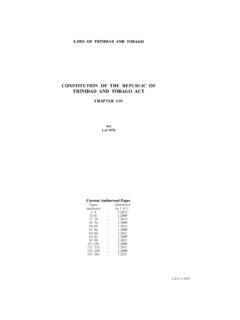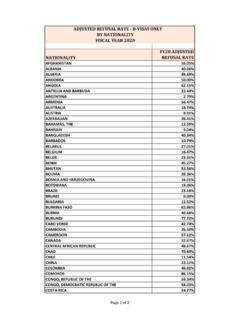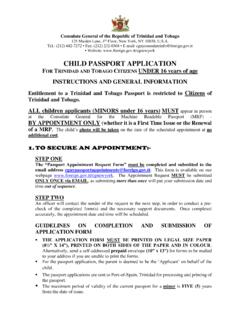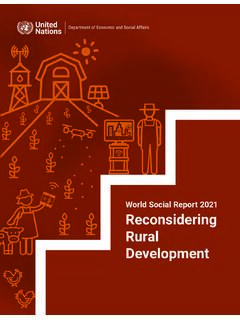Transcription of WHO global estimates on prevalence of hearing loss
1 WHO global estimates on prevalence of hearing loss Mortality and Burden of Diseases and Prevention of Blindness and Deafness WHO, 2012 In 2012, WHO released new estimates on the magnitude of disabling hearing loss. The estimates are based on 42 population-based studies. estimates are as follows: There are 360 million persons in the world with disabling hearing loss ( of the world s population). 328 million (91%)of these are adults (183 million males, 145 million females) 32 (9%) million of these are children. The prevalence of disabling hearing loss in children is greatest in South Asia, Asia Pacific and Sub-Saharan Africa. Approximately one-third of persons over 65 years are affected by disabling hearing loss.
2 The prevalence of disabling hearing loss in adults over 65 years is highest in South Asia, Asia Pacific and Sub-Saharan Africa. Regions, are as identified by the Institute of Health Matrix and Evaluation s 2010 GBD estimates study. Definition of disabling hearing loss Disabling hearing loss refers to hearing loss greater than 40 dB in the better hearing ear in adults (15 years or older) and greater than 30 dB in the better hearing ear in children (0 to 14 years). Details of Selected Regions Subregion Countries East Asia region East Asia China, Hong Kong SAR (China), Macau SAR (China), Democratic People's republic of Korea, Taiwan. Asia Pacific region Southeast Asia Cambodia, Indonesia, Lao People's Democratic republic , Malaysia, Maldives, Myanmar, Philippines, Sri Lanka, Thailand, Timor-Leste, Viet Nam.
3 Oceania Cook Islands, Fiji, French Polynesia, Kiribati, Marshall Islands, Micronesia (Federated States of), Nauru, Palau, Papua New Guinea, Samoa, Solomon Islands, Tonga, Vanuatu, Tuvalu and Niue. South Asia region South Asia Afghanistan, Bangladesh, Bhutan, India, Nepal, Pakistan Central / Eastern Europe and Central Asia region Central Asia Armenia, Azerbaijan, Georgia, Kazakhstan, Kyrgyzstan, Mongolia, Tajikistan, Turkmenistan, Uzbekistan. Central Europe Albania, Bosnia and Herzegovina, Bulgaria, Croatia, Czech republic , Hungary, Montenegro, Poland, Romania, Serbia, Slovakia, Slovenia, Macedonia (Former Yugoslav republic of). Eastern Europe Belarus, Estonia, Latvia, Lithuania, Moldova, Russian Federation, Ukraine.
4 Middle East and North Africa region North Africa and Middle East Algeria, Bahrain, Egypt, Iran (Islamic republic of), Iraq, Jordan, Kuwait, Lebanon, Libyan Arab Jamahiriya, Morocco, Occupied Palestinian Territory, Oman, Qatar, Saudi Arabia, Syrian Arab republic , Tunisia, Turkey, United Arab Emirates, Yemen. Sub-Saharan Africa region Central Africa Angola, Central African republic , Congo, Democratic republic of the Congo, Equatorial Guinea, Gabon. East Africa Burundi, Comoros, Djibouti, Eritrea, Ethiopia, Kenya, Madagascar, Malawi, Mauritius, Mozambique, Rwanda, Seychelles, Somalia, Sudan, Uganda, United republic of Tanzania, Zambia. Southern Africa Botswana, Lesotho, Namibia, South Africa, Swaziland, Zimbabwe.
5 West Africa Benin, Burkina Faso, Cameroon, Cape Verde, Chad, C te d'Ivoire, Gambia, Ghana, Guinea, Guinea-Bissau, Liberia, Mali, Mauritania, Niger, Nigeria, Senegal, Sierra Leone, S o Tom and Pr ncipe, Togo. Latin America and Caribbean region Andean Latin America Bolivia, Ecuador, Peru. Central Latin America Colombia, Costa Rica, El Salvador, Guatemala, Honduras, Mexico, Nicaragua, Panama, Venezuela (Bolivarian Rep. of). Southern Latin America Argentina, Chile, Uruguay. Tropical Latin America Brazil, Paraguay. Caribbean Antigua and Barbuda, Bahamas, Barbados, Belize, Bermuda, British Virgin Islands, Cuba, Dominica, Dominican republic , Grenada, Guyana, Haiti, Jamaica, Netherlands Antilles, Puerto Rico, Saint Kitts and Nevis, Saint Lucia, Saint Vincent and the Grenadines, Suriname, trinidad and tobago .
6 High-income region Asia-Pacific Brunei Darussalam, Japan, republic of Korea, Singapore. Australasia Australia, New Zealand. North America Canada, United States of America. Western Europe Andorra, Austria, Belgium, Cyprus, Denmark, Finland, France, Germany, Greece, Greenland, Iceland, Ireland, Israel, Italy, Luxembourg, Malta, Netherlands, Norway, Portugal, Spain, Sweden, Switzerland, United Kingdom, Monaco and San Marino. Data sources Indicator Source hearing Loss estimates MBD: All degrees of hearing loss for adults and children WHO, 2012 hearing Loss estimates Population 2008 estimates *UNDP 2010 World Population Prospects GNI per capita, Atlas method (current US $ Dollars) **Worldbank Database 2008 Literacy rate, adult total (% of people ages 15 and above) **Worldbank Database 2009 *UNDP WPP available at: **Worldbank database available at: prevalence of hearing loss: WHO global estimates *Children: 32m 9% Males: 183m.
7 56% Females: 145m. 44% *Adults: 328 m. 91% *MBD, WHO, 2012 DHL estimates ; DHL adults (15+ years) threshold is 41 dB and children threshold is 31 dB. Disabling hearing loss is unequally distributed across the world High-income 11% Central/East Europe and Central Asia 9% Sub-Saharan Africa 9% Middle East and North Africa 3% South Asia 27% Asia Pacific 10% Latin America & Caribbean 9% East Asia 22% MBD, WHO, 2012 DHL estimates ; DHL adult threshold is 41 dB, adults of 15 years or older. prevalence of disabling hearing loss in some regions is nearly double that of the high income region. Selected Regions DHL in children DHL in adults Both sexes Males Females millions prevalence (%) millions prevalence (%) millions prevalence (%) High-income 19 18 Central/Eastern Europe and Central Asia 14 16 Sub-Saharan Africa 17 13 Middle East and North Africa 6 4 South Asia 52 36 Asia Pacific 19 15 Latin America and Caribbean 15 13 East Asia 41 30 World 183 145 MBD, WHO, 2012 DHL estimates prevalence of disabling hearing loss for adults by region.
8 0%1%2%3%4%5%6%7%8%9%10% prevalence of Disabling hearing Loss for adults prevalence of Disabling hearing Loss for adults 15+ years oldPrevalence of Disabling hearing Loss for males 15+ years oldPrevalence of Disabling hearing Loss for females 15+ years old*MBD, WHO , 2012, DHL estimates , where DHL adult threshold is 41 dB HL prevalence of disabling hearing loss in children: The prevalence for disabling hearing loss in children is highest in the south Asia region followed by Sub-Saharan Africa. There is a marked difference in the prevalence rates in high income parts of the world. 0%1%2%3% prevalence of Disabling hearing Loss *MBD, WHO, 2012 DHL estimates , where DHL children threshold is 31 dB prevalence of hearing loss for adults by degree of hearing loss: Approximately 15% of the world's adult population has some degree of hearing loss.
9 About one third of those who are affected, have disabling hearing loss. of Disabling hearing Loss for adults (15 years or older) Slight impairment (26-40dB)Moderate impairment (41-60dB)Severe impairment (61-80dB)Profound impairment (>80dB)* MBD, WHO, 2011 DHL estimates , where DHL adult threshold is 41 dB. prevalence of disabling hearing loss for children, adults: 15 years or older, and 65 years or older: The prevalence increases with age, prevalence in children is , in adults aged 15 years or more, it is around 7%, rapidly increasing to almost one in three in adults older than 65 years. 0%5%10%15%20%25%30%35%40%45%50%Prevalenc e of Disabling hearing Loss prevalence of DHL for children until 14 years old (per 100 children) prevalence of DHL for adults 15 years or older (per 100 populuation) prevalence of DHL for adults 65 years or older (per 100 population)*MBD, WHO, 2012 DHL estimates , where DHL adult threshold is 41 dB and children threshold is 31 dB (children 0 until 14 years old).
10 prevalence of Disabling hearing Loss for children versus average GNI per capita:* In children, prevalence decreases exponentially as GNI increases. _____ *GNI per capita: gross national income per capita High Income: Cent/East Europe and Cent S-Sahara Africa: Middle East and North Africa: South Asia: Asia Pacific: 2% Latin America and Caribbean: East Asia: y = 0% 1% 1% 2% 2% 3% 3% 4% - 5 10 15 20 25 30 35 40 45 50 prevalence of Disabling hearing Loss for children Average GNI per capita (thousands US Dollars) prevalence of Disabling hearing Loss for children until 14 years old*MBD, WHO, 2012 DHL estimates , prevalence of disabling hearing loss for adults (65 years or older) versus average GNI per capita:* High Income: 18% Cent/East Europe and Cent Asia 36% S-Sahara Africa.
















